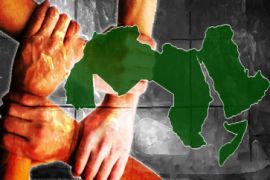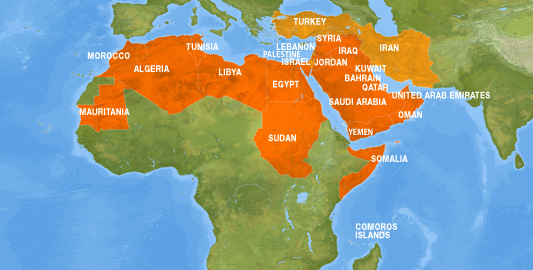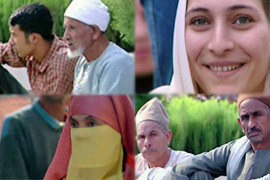Arabs seek common cause
Spanning 22 countries with 320 million people, they share three general commonalities.

 |
| The Arab world covers a vast geographic area stretching from the Atlantic coast to the Gulf |
Arabs share a common language and a common history, but in their hope for unity, they have been pulled in many directions.
Years of colonialism and cultural influence in the region have split Arabs between those seeking a more traditional past and those seeking world superpower-inspired modernisation.
Political movements such as Islamism clashed with secularism while authoritarian systems of governance resisted democratic reform.
Al Jazeera’s nine-part series, A Question of Arab Unity, traces the struggle to unite from the cultural renaissance of the 19th century through the turbulent 20th century which was marked by dictatorships, political ideologies, monarchies and teetering democracies.
Part one, Why Unity?, examines the historical roots of Pan-Arabism and asks what it means to be an Arab.
The Arab world covers a vast geographic landscape comprising 22 countries. Mountain ranges crisscross two continents, acting as barriers separating farmland and coastal strips from virtually uninhabited deserts in a region stretching from the Atlantic shores of Morocco to the Gulf.
Traditionally, the Bedouin of the deserts maintained a lifestyle different from the inhabitants of the great river valleys of Iraq and Egypt or the urban societies of the Mediterranean.
But, whatever differences may separate Arabs, there are three general commonalities: they all speak Arabic, 95 per cent are Muslim and most, at some point and in different ways, have sought unity.
Caliphate power base
| Articles in this episode |
|
Reformers, liberators, and martyrs Time to forget the Crusades Science in the Arab Empire Made by Muslims Lebanon’s men of letters Scholar: No clash of civilisations In the land of Abraham |
In the first 50 years after the death of the Prophet Muhammad, Islam was an Arab religion and the caliphate an Arab kingdom. The term Arab was applied to those who were full members by descent of an Arab tribe, and who, either in person or through their ancestors, had originated in Arabia.
The Arabic language, a Semitic language akin to Hebrew, Aramaic and Amharic, bound the Arabs together providing them with the same cultural mannerisms and identity.
But after the eighth century, the role of the Arab caliphate began to decline giving way to non-Arab dynasties which gained control of the state.
As the new Muslims pushed north, east and west, the caliphate was gradually transformed from an Arab to an Islamic empire, incorporating non-Arabs such as Kurds, Persians, Berbers and Ottomans.
It was in this period that there was an explosion of ideas and innovation. New concepts in mathematics, science, agriculture, philosophy and art exemplified the new Islamic empire and in later years influenced the European renaissance.
Innovations such as toxicology, the first medical encyclopaedia, the astrolabe and the use of the numeral zero ushered in an age of Arab invention and scientific breakthrough.
But after the last Christian crusade in the 13th century and the sacking of Baghdad, the capital of the Abbasid empire, in 1258, the sun set on the new Arab empire. Gone were the philosophers and scientists as the accumulated written knowledge compiled by the Arabs was destroyed.
It was during this period that Ottoman Turkic peoples came to dominate the Islamic caliphate.
They relocated the Islamic focus of power from Mecca to Constantinople, soon renamed Istanbul.
Arab renaissance
 |
| The Arab world is comprised of peoples of different background and religion |
It would not be until the Arab renaissance of the 19th century that the concept of a single unified Arab state would emerge and embed itself into the fabric of Arab consciousness, becoming crystallised after Gamal Abdel Nasser, the iconic Egyptian president from 1956-1970, came to power.
It has been called Pan-Arabism, Arab Nationalism, or just plain Arabism and it first arose as a direct reaction to the decline of the Ottoman empire.
By the middle of the 19th century, Arabs began to resist Ottoman reforms, especially ones imposing the Turkish language in schools, and discontent spread throughout the Arabic-speaking provinces of the empire. This discontent would come to be known as the Nahda – the Arab “awakening”.
One of the central principles of the Nahda was the idea of one single unified Arabic nation built on dialogue, rationality and secularism.
Politicians and intellectuals such as Butros al-Bustani, Nassif and Ibrahim Yaziji from Lebanon, the Iraqi Sati El Husri, and Abdel Rahman al-Kawakibi from Syria argued that the Arabs from the Gulf to the Atlantic were one people and ought to be united in one social and political entity.
Fawwaz Traboulsi, a political analyst, says: “I think the ideals of the Nahda still make sense in this world. They make a lot of sense in our world; freedom from all forms of oppression, the rule of law, the republic, the question of the relationship between religion and belief, the reinterpretation of religion, is religion open to individual interpretation or is it closed?”
“Finally, [there is] the question of social justice. All those are common notions of the Nahda.”
They called for Arabs to educate, empower and emancipate themselves from Ottoman hegemony and demanded that the caliphate power be based in Mecca.
Catchphrases
But the struggle for Arab unity has been plagued from the beginning by definitions and differing interpretations of identity and nationalism.
Ahmad Youssef Ahmad, the director of the Arab Institute for Research and Study, says: “There are those Arab nationalists who prefer to use the term Arab nation instead of Arab world… One could say that the reality at present is the Arab world, but our ambition is to be the Arab nation.”
Arab unity has meant different things to different people at different times.
For some such as Sheriff Hussein of Mecca at the beginning of the 20th century, unity was a way to defeat Ottoman colonialism. For his son, King Faisal, unity was an expression of resistance to the colonialism of Britain and France.
The region’s religious and ethnic minorities sought a secular Arab unity while Islamist movements, including the Muslim Brotherhood, wanted to emulate the glories of their collective past in an Islamic caliphate.
For others, including Nasser, or the secular pan-Arab Baath party, unity was suggested as a mechanism to liberate Palestine from Israeli occupation and to create one over-arching Arab sovereign state.